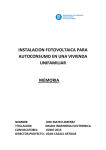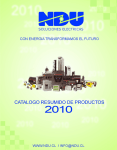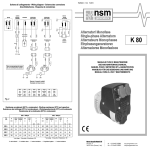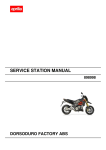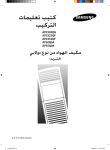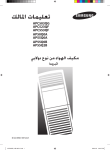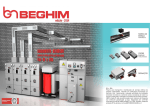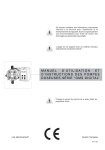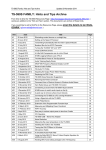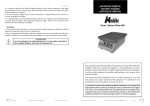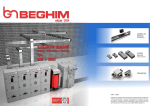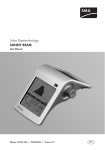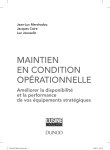Download telergon manual motorización ESP.indd
Transcript
Ref. 4257Z001 Rev. 05 Motorised unit Changeover switch installation and operation guide Edition September 2007 Index Please follow carefully the instructions included in this manual for a correct installation and operation. If you need further information, please contact our Technical Dept. Verification of the parts contained in this unit Safety warnings Standards Installation/Mounting Product guide ..................................... ......................................................................................................................... .......................................................................................................................................... ....................................................................................................... ............................................................................................................................. 1 1 1 2 5 - Supply voltage - Output signals - Input signals - RS485/MODBUS Communication - Operation selector - Protection fuse - Position Led’s - Error Led’s Operation modes ................................................................................................................... 8 - Manual operation - Motorised operation - Lock mode Annexes ......................................................................................................................................... - Annexe 1: Table of references - Annexe 2: Dimensions - Annexe 3: Wiring diagram - Annexe 4: Wiring voltage drop - Annexe 5: Table of fuse ratings - Annexe 6: Table of electrical features - Annexe 7: EMC Table 12 Verification of the parts contained in this unit Before installation ensure that the following parts are included in the carton box: Motorised unit . Plastic bag containing screws for fixing the motorised unit to the changeover, and electrical connectors. Changeover - motorised unit coupling shaft. Manual handle for direct operation. User manual. Safety warnings In the installation and during the operation of the motorised unit it is necessary to observe the following recommendations: Make sure that the voltage of the motorised unit coincides with the voltage we are going to work with, and the motorised unit is suitable for the changeover that is going to drive (See annexe 1, page 12). Before installation ensure that both the changeover and the motorised unit are in 0 (OFF) position. Qualified personnel must install the motorised unit. Follow carefully the installation instructions and the wiring diagrams. The motorised unit must be installed on the changeover switch before being operated. Do not switch the voltage supply until the whole wiring operation has been made. Do not dismantle, repair or modify this unit, as it may cause malfunctioning or electrical descharges. Do not supply voltage or connect the motorised unit if any of the parts are damaged. Take into account possible voltage drops in the wiring. (See annexe 4, page 16). Telergón is not responsible for inappropriate use of the motorised unit or the misinterpretation of the information contained in this document. The installation of this device in a domestic environment can cause radiofrecuency interference. If the secondary line of the changeover switch is a generator set, make sure that the generator set switches off after retransferring the lines (t>1 min.). Standards - IEC/EN 60947-1 y 3. Low voltage devices. General part and Switch - Disconnectors. - IEC/EN/UNE 61000-6, Parts 2 y 4. Electromagnetic compatibility in industrial environments, immunity and emission. This product is under - According to European standard 2006/95/CE for Low voltage. - According to European standard 2004/108/CE of EMC. marking NOTE: The content of this document can be modified without previous warning. 1 Installation / Mounting Ensure that the voltage of the motorised unit coincides with the voltage we are going to work with, and the motorised unit is suitable for the changeover that is going to drive. (See annexe 1, page 12). Before installation make sure that both the changeover and the motorised unit are in position 0 (OFF). The motorised unit must be installed on the changeover switch before being operated following next steps. FOR CHANGEOVER SERIES CC 200... 1250A 2,5 DIN 911-90 (x1) 1 Set the changeover in its place and fix the bars 2 Insert the shaft in the changeover and tighten using the supplied spanner (2,5 DIN 911-90 (x1)) CN1, CN2, CN3, MODBUS A.E.T. 5,3 (x 6) M5 x 20 DIN7985 (x 6) 3 Screw the motorised unit (with both changeover and in position 0 ). M5x20 DIN7985 screws (x6) and A.E.T. 5,3 washers (x6) included 2 4 Fix connectors (CN1,CN2,CN3,MODBUS) and connect according to the wiring diagram (See annexe 3, page 15) Installation / Mounting FOR CHANGEOVER SERIES S5000F / 1600A - 1800A A.E.T. 5,3 (x 6) M5 x 20 DIN7985 (x 6) SERPRESS M5 (x 6) 1 Set the changeover in its place and fix the bars 2 Screw the motorised unit (with both changeover and in position 0 ). M5x20 DIN7985 screws (x6), A.E.T. 5,3 washers (x6) and Serpress M5 nuts (x6) included CN1, CN2, CN3, MODBUS 3 Fix connectors (CN1,CN2,CN3,MODBUS) and connect according to the wiring diagram (See annexe 3, page 15) 3 Installation / Mounting MOUNTING POSITIONS The limitations of the motorised unit depend on the changeover mounting position. CCF S5000F 4 * For inverted mountings there are references for motorised units with inverted frontal plates. Supply under request. Product guide A B C D E A Supply voltage B Output signals C Input signals D RS485/MODBUS Communication E OFF Operation selector F Protection fuse G H G Position Led’s H Error signals F Transmission features Fuse Code UM-C31230A Motor torque M M≤110Nm RS-485 - MODBUS 230Vac - 50/60 Hz MADE IN DIR: 04 SPAIN MODE: 9600, N, 1 5x20 3,15A (T) www.telergon.es RTU MODE EN-61000-6-4 IEC-60947-3 EN-61000-6-2 Voltage supply 5 Product guide A - VOLTAGE SUPPLY The motorised unit requires a voltage supply for its operation (terminals 1-2). For the motorised unit to have an uninterrupted supply system (mains-secondary sources), the client shall prepare a circuit similar to the example (*) at page 15. Terminales 1-2 Supply Ground connection PE Terminal max. capacity: 4 mm2 (without clamps) / 2,5 mm2 (with clamps). B - OUTPUT SIGNALS Indicate the current position of the changeover. Depending on the position of the changeover, we shall have a 24Vdc output signal between the respective terminal and the common one. These outputs can be used to operate an actuator (lamp, relay, led, etc.). Changeover situation Position 0 Position I Position II Terminal 6 Common 5 7 5 8 5 Imax 200mA x terminal. Terminal max. capacity: 1,5 mm2 (without clamps) / 1 mm2 (with clamps). Take into account terminals polarity (see annexe 3, page 15). Do not short-circuit the terminals with the common one. C - INPUT SIGNALS The electrical inputs indicate to the motorised unit the position to move. When closing the circuit we have a 24Vdc signal, internally provided by the motorised unit. The switching order is carried out by closing the circuit through a (non-voltage) contact between one of the terminals and the common one. Switching order Go to position 0 Go to position I Go to position II Terminal 12 Common 9 11 9 10 9 Terminal max. capacity: 1,5 mm (without clamps) / 1 mm2 (with clamps). 2 RS485/MODBUS COMMUNICATION It permits the total digital control of the motorised unit with the input/output management. See page 10 for table with addresses and operation. + Common Terminal A B SG Terminal max. capacity: 1,5 mm2 (without clamps) / 1 mm2 (with clamps). 6 Product guide E - OPERATION SELECTOR Selector Position Description MAN Operation only with the manual handle, electric operation not possible. AUT Motorised operation with inputs/outputs o RS485 MODBUS. BLC Lock position, manual and motorised operation not possible. PRESS TO MAN PRESS TO MAN Note: For changing the selector from AUT to MAN press the lever behind the yellow selector. F - PROTECTION FUSE Fuse 5x20 delayed type (T). High breaking capacity (HBC), 1,5kA, ceramic. See fuse rating table in annexe 5. G - POSITION LED’S They indicate the current position of the changeover. According to the position in which the changeover is, the respective led will be illuminated. H - ERROR SIGNALS The motorised unit has a diagnostic system that discriminates the error signal according to the signal type of the led. Motorised unit error Signal: Intermittent led with a 1Hz frequency. Cause: Internal fault in the motorised unit. Solution: Contact the manufacturer. Operation malfunctioning Signal: Intermittent led with a 5 Hz frequency. Cause: Not switching when commanding. Solution: Operate again the current position of the changeover. Blown Fuse Signal: Fixed led. Cause: Protection fuse melt. Solution: Replace the fuse. If the fuse keep melting, please contact the manufacturer. Manipulation error Signal: Intermittent led with a 5 Hz frequency, selector in position AUT, yellow latch broken. Cause: Undue manual operation with the selector in AUT. Solution: Switch off and switch on the supply again. 7 Operating modes There are 3 operating modes selectable with the frontal yellow selector (E): Manual operation Automatic operation Lock mode Manual operation To operate in this operating mode the frontal selector has to be in the manual position. From AUT position we pass to MAN position by pressing the lever behind the yellow selector. The changeover switch can be operated only with the direct handle. Inputs Automatic operation is not possible in this position. It doesn’t respond to the commands entered by the communication bus nor to the electric signals. Information about the changeover position is sent via MODBUS. Example of manual operation: Manual operating mode Outputs We shall have a 24Vdc output (200 mA max) between the common terminal n.5 and terminals 6 (position 0 ), n.7 (position I ), 8 (position II ). These outputs can be used to operate an actuator (lamp, relay, led, etc.). Take into account terminals polarity (see annexe 3, page 15). Do not short-circuit the terminals with the common one. Automatic operation The changeover can be remote-controlled in two ways. Control through electric inputs/outputs MODBUS control 8 In this operation mode the system can be driven in any of these control modes. The motorised unit executes the first input signal. In order to avoid duplicate signals, when we give an order via MODBUS, the signal inputs will be blocked automatically, and then unblocked when the motorised unit reaches the required position. Between two signals, the motorised unit disables the signal inputs during two seconds. Automatic operation OPERATION MODE AUTO (inputs/outputs) Inputs The switching is made by pulse or maintained contact. CONTROL BY PULSE The switching order is made by pulse between terminal 9 and terminals 12 (position 0 ), 11 (position I ) y 10 (position II ). Minimum duration of pulse 100 ms. Example of control by pulse: Tmin = 100 ms. CONTROL BY PULSE IN (0) IN (1) IN (2) CONTROL BY MAINTAINED PULSE The switching order is made by maintained pulse between terminal 9 and terminals 12 (position 0 ), 11 (position I ) y 10 (position II ). Example of control by maintained contact: CONTROL BY MAINTAINED PULSE IN (0) IN (1) IN (2) Outputs We shall have a 24Vdc output (200 mA max) between the common terminal n.5 and terminals 6 (position 0 ), n.7 (position I ), 8 (position II ). These outputs can be used to operate an actuator (lamp, relay, led, etc.). Take into account terminals polarity (see annexe 3, page 15). Do not short-circuit the terminals with the common one. 9 Operating modes OPERATION MODE AUTO (MODBUS protocol) The devices communicate themselves through the MODBUS protocol, using a technique master-slave where only one device (the master) can start transactions (requests). Other devices (slaves) respond providing to the master the requested date, or realizing the requested action. During the transmission, the motorised unit uses a speed of 9600 baud, the address of the device is04h and it uses 8 bits without parity and with 1 stop bit in RTU format. The MODBUS protocol indicates the format for the master’s request, and it includes the address of the slave device, a code of function that defines the requested action, any data to be sent and a field for error checking. (When there is more than one, it will be necessary to put different addresses for each unit. This function shall be done in the factory under client’s request). Slave answer message is also defined by the MODBUS protocol. It contains fields that confirm the action, any data to be returned and a field for error checking. If the message received by the slave is defective, or the slave is unable to make the requested action, it will generate an error message and send it as an answer. ACTUATION ORDERS To drive the changeover, function n.5 (Force single coil) is used as follows. Slave address Function High address Low address coil Force data high Force data low CRC high CRC low Meaning - 05h 00h 00h FFh 00h - - Go to 0 05h 00h 01h FFh 00h - - Go to 1 05h 00h 02h FFh 00h - - Go to 2 (04h default) The answer for a correct order is an echo to the received one. The answer for a right order has the following form: Slave address Function Error code CRC high CRC low Meaning - 85h XXh - - Function error (04h default) Where the value of the exception code XXh is among the following ones: Code Name Meaning 01h Illegal function Function not recognised 02h Illegal data address Data address not valid. if not is 0000h, 0001h o 0002h 03h 04h Illegal data value Data field not valid. different to FF00h Slave device failure If the motor fails, there is an internal failure, or blown fuse (04h default) DATA REQUEST The function used is 02h “Read Input Status” and is used in the next general form: Slave address Function - 02h (04h default) 10 Starting address Starting address high low 00h 00h Number of points high Number of points low CRC high CRC low Meaning 00h 10h - - Data request Operating modes The answer for this request is: Slave address (04h default) Function Bytes number Second byte 8-F First byte 0-7 CRC high CRC low Meaning 02h 02h XXh XXh - - Answer THE MEANING OF THE BITS OF THE RETURNED WORD In order to code the different answers returned, every bit of the two bytes returned is used with the following meanings: First byte Second byte Bit address State Meaning State Meaning 0 0 The changeover is NOT in 0 1 The changeover is in 0 1 0 The changeover is NOT in I 1 The changeover is in I 2 0 The changeover is NOT in II 1 The changeover is in II 3 0 4 0 Automatic detector NOT activated 1 Automatic detector activated 5 0 Lock detector NOT activated 1 Lock detector activated 6 0 7 0 8 0 NO manipulation error 1 Manipulation error, it has been moved 9 0 NO operation error 1 Operation error, does not reach the objective A 0 NO error of relay 1 Error of UM B 0 NO Blown fuse 1 Blown Fuse 1 1 C 0 Configured in switch mode 1 Configured in changeover mode D 0 Pushbutton “go to 0” NOT actuated 1 Pushbutton “go to 0” actuated E 0 Pushbutton “go to I” NOT actuated 1 Pushbutton “go to I” actuated F 0 Pushbutton “go to II” NOT actuated 1 Pushbutton “go to II” actuated Note: Bits 0, 1 and 2 are activated separately; if one of them is activated, the other two must be deactivated. Note: If both the bits 4 and 5 are in 0, the motorised unit is in MAN. They can’t be both activated at the same time. The answer for an error has the following form: Slave address (04h default) Function Error code CRC high CRC low Meaning 82h XXh - - Answer error Where the value of the code XXh is among the following ones: Code Name Meaning 01h Illegal function Function not recognised 02h Illegal data address Invalid data address, if is different to 0000h 03h Illegal data value Invalid data value, if is different to 0010h Lock mode In this mode it is not possible to operate the switch in either manual or electric modes. We reach this position by lowering completely the yellow lever. This is an unstable position. In order to keep it, we can set up to 3 padlocks (max. Ø6). 11 Annexe 1 REFERENCES The range of motorised unit is available from 200 to 1.800A*, and supply voltages are 120, 230, 277 Vac. Changeover I-0-II 3P 3P+N A Series Code Code 200 CCF CCF02003PS0 CCF02003NS0 250 CCF CCF02503PS0 CCF02503NS0 315 CCF CCF03153PS0 CCF03153NS0 400 CCF CCF04003PS0 CCF04003NS0 500 CCF CCF05003PS0 CCF05003NS0 630 CCF CCF06303PS0 CCF06303NS0 800 CCF CCF08003PS0 CCF08003NS0 1000 CCF CCF10003PS0 CCF10003NS0 1250 CCF CCF12503PS0 CCF12503NS0 1600 S5000F S5F16003PS0 S5F16003NS0 1800 S5000F S5F18003PS0 S5F18003NS0 Motorised unit 120 V ac 230 V ac 277 V ac Torque A Series Last code Last code Last code Nxm 200 CCF UM-C11120A UM-C11230A UM-C11277A 18 250 CCF UM-C11120A UM-C11230A UM-C11277A 18 315 CCF UM-C15120A UM-C15230A UM-C15277A 25 400 CCF UM-C15120A UM-C15230A UM-C15277A 25 500 CCF UM-C21120A UM-C21230A UM-C21277A 57 630 CCF UM-C21120A UM-C21230A UM-C21277A 57 800 CCF UM-C25120A UM-C25230A UM-C25277A 78 1000 CCF UM-C31120A UM-C31230A UM-C31277A 110 1250 CCF UM-C35120A UM-C35230A UM-C35277A 150 1600-1800 S5000F UM-C35120A UM-C35230A UM-C35277A 150 For inverted mountings there are references for motorised units * Please consult for 2000, 2500 and 3150A. 12 with inverted frontal plates. Supply under request. Annexe 2 DIMENSIONS 112 98 H B ø5 ,5 10 16 F G A A 55,5 C D E M Max. Nxm A B C D E F G H I J K L M Max. Nxm 18 52,5 133 117 150 150 237 380 245 310 235 383 254 25 UM-C15120A UM-C11120A UM-C11230A UM-C11277A UM-C15277A UM-C25120A UM-C21120A UM-C21230A UM-C15230A 57 88,5 167 153 184 172 312 455 361 339 321 468 283 78 UM-C25230A UM-C21277A UM-C25277A UM-C31120A UM-C35120A UM-C31230A 110 88,5 167 153 184 172 312 455 361 367 424 522 311 150 UM-C31277A For inverted mountings there are references for motorised units UM-C35230A UM-C35277A with inverted frontal plates. Supply under request. * Please consult for 2000, 2500 and 3150A. 13 Annexe 2 (200... 1250A) I K CCF + (1600-1800A) 459 447 552 14 503 532 S5000F + H L J 361 Annexe 3 WIRING DIAGRAM MAINS MODBUS Input signals IN (0 ), IN (I ), IN (II ) When closing the circuit we have a 24Vdc signal, internally provided by the motorised unit. The switching order is carried out by closing the circuit through a (non-voltage) contact between the common terminal 9 and terminals 12 (position 0 ), 11 (position I ) and 10 (position II ). Output signals OUT (0 ), OUT (I ), OUT (II ) Depending on the position of the changeover we shall have a 24Vdc output (200 mA max) between the common terminal n.5 and terminals 6 (position 0 ), n.7 (position I ), 8 (position II ). These outputs can be used to operate an actuator (lamp, relay, led, etc.). Take into account terminals polarity. Do not short-circuit the terminals with the common one. Note: Indicative electric drawing. * WIRING PROPOSED FOR EXTERNAL UNINTERRUPTED SUPPLY K1, K2 = 230 Vac = Coil 230 Vac K1, K2 = 120 Vac = Coil 120 Vac K1, K2 = 277 Vac = Coil 277 Vac K1, K2 relays electric and mechanically interlocked 4 3 2 1 PE JP4 4 3 2 1 PE CONNECTOR GND A1 11 21 31 31 21 11 A1 A2 12 24 34 34 24 12 A2 K1 K2 mains secondary sources 15 Annexe 4 VOLTAGE DROPS IN THE WIRING 1 MAINS 2 1-2 L (∆V≤5% VL-N) S (Cu) (mm2) 120 Vac 230 Vac 277 Vac 120 Vac 230 Vac 277 Vac 120 Vac 230 Vac 277 Vac UM-C11120A UM-C11230A UM-C11277A UM-C21120A UM-C21230A UM-C21277A UM-C31120A UM-C31230A UM-C31277A 1,5 2,5 4 264 670 940 75 250 380 49 160 244 440 1100 1560 125 420 635 80 270 400 700 1800 2000 200 675 1015 130 435 650 UM-C15120A UM-C15230A UM-C15277A UM-C25120A UM-C25230A UM-C25277A UM-C35120A UM-C35230A UM-C35277A 120 Vac 230 Vac 277 Vac 120 Vac 230 Vac 277 Vac 120 Vac 230 Vac 277 Vac S max without clamp 4 mm2 / S max with clamp 2,5 mm2 5 12 5-12 L (∆V=5% 24 V) S (5-12) = 1,5 mm2 Cu max. => LMAX = 210 m => ∆V = 5% 24 V = 1,2 V A B SG A-B-SG S (A-B-SG) = 1,5 mm2 max. => LMAX = 1.000 m => Shielded stranded pair / Line impedance = 100 Ω Annexe 5 FUSE RATING TABLE Voltage 120 Vac 230 Vac 277 Vac 120 Vac 230 Vac 277 Vac 120 Vac 230 Vac 277 Vac Referenceggg UM Fuse 5 x 20 (A) UM-C11120A / UM-C15120A UM-C11230A / UM-C15230A UM-C11277A / UM-C15277A UM-C21120A / UM-C25120A UM-C21230A / UM-C25230A UM-C21277A / UM-C25277A UM-C31120A / UM-C35120A UM-C31230A / UM-C35230A UM-C31277A / UM-C35277A 0,8 0,5 0,4 3,15 2 1,6 5 3,15 2,50 Note: Time delay fuse 5x20 - High breaking capacity (1,5 kA) ceramic. 16 Annexe 6 ELECTRICAL FEATURES V 120 Vac +/-15% Frequency Hz 50/60 Ambient temperature Un ºC Supply voltage 230 Vac +/-15% 277 Vac +/-15% 50/60 60 -40º / +65º (2) Maximum load while transferring For COS ratings from 200 to 400A A 1.025 0.695 0.595 For COS ratings from 630 to 800A A 3.415 1.965 1.595 For COS ratings from 1000 to 1800A A 5.325 3.075 2.475 Minimum idle load A 0.225 0.225 0.225 For COS ratings from 200 to 400A s 0.208 0.192 0.200 For COS ratings from 630 to 800A s 0.180 0.168 0.174 For COS ratings from 1000 to 1250A s 0.166 0.148 0.154 For COS ratings from 1600 to 1800A s 0,172 0,175 0,169 For COS from 200 to 400A 7000/10000 7000/10000 7000/10000 For COS from 500 to 630A 4000/10000 4000/10000 4000/10000 For COS of 800A 2500/10000 2500/10000 2500/10000 For COS from 1000 to 1800A 2500/7000 2500/7000 2500/7000 Transfer time (maximum values) Maximum number of operations (1) Maximum number of operations hour (1) For COS from 200 to 400A 120/120 120/120 120/120 For COS from 500 to 630A 60/120 60/120 60/120 For COS from 800A 20/120 20/120 20/120 For COS from 1000 to 1800A 20/60 20/60 20/60 ( ) According to IEC-EN 60947-1 / Based in our own tests (2) 90% Relative humidity 1 Annexe 7 EMC TABLE Immunity Standard Criterion Level Characteristics Electrostatic discharges EN 61000-4-2 A Special ± 8 kV air discharge ± 4 kV equipment discharge Electromagnetic H.F. field EN 61000-4-3 A 3 10 V/m Fast transients (Burst) EN 61000-4-4 A 4 ± 4 kV power supply ± 2 kV signal supply Fast transient (surge discharge) EN 61000-4-5 A Special Conducted disturbances EN 61000-4-6 A 3 10 V supply and signal Electromagnetic field, industrial frequency EN 61000-4-8 A 4 Field intensity 30 A/m EN 61000-4-11 A B - 60% Un - 1000 ms 95% Un - 5000 ms Standard Criterion Level EN 61000-3-2 - 3 3 0,02 A total current (manual mode) 0,04 A total current (aut. mode) Unwanted voltage EN 55011 - 3 Qualified Radiated emission EN 55011 3 Qualified Voltage dips, interruptions and voltage variations Emission Emission of harmonic current ± 4 kV power supply L1-L2 Generator impedance 2Ω (wave 1.2/50μs) Characteristics EN 61000 is equivalent to IEC 61000 - EN 55011 is equivalent to CISPR11 CRITERION A: Normal service behaviour in determined limits CRITERION B: Transient alteration of the service. The appliance gets back to the normal performing without the intervention of the operator Test level 3: Typical industrial environment, without special installation measures Test level 4: Severe industrial environment Special level: level of higher electromagnetic severe environment 17 TDM-UMC-072007 - JULIO/JULY 2007 Telergón, S.A. reserves the right to modify the products herein illustrated without prior notice. Technical data and description in the document are accurate at the printing date, but no liabilities for errors or omissions are accepted. No danger or hazard to health and safety will be caused when products are installed, maintained and used in applications for which they are designed, in accordance with “professional practices” and manufacturer’s instructions. Telergón, S.A. Ctra. Castellón (Pol. La Cartuja) 50720 La Cartuja Baja Zaragoza / España 18 Tel.: + 34 976 50 08 76 Fax: + 34 976 50 03 14 E-mail: [email protected] www.telergon.es





















